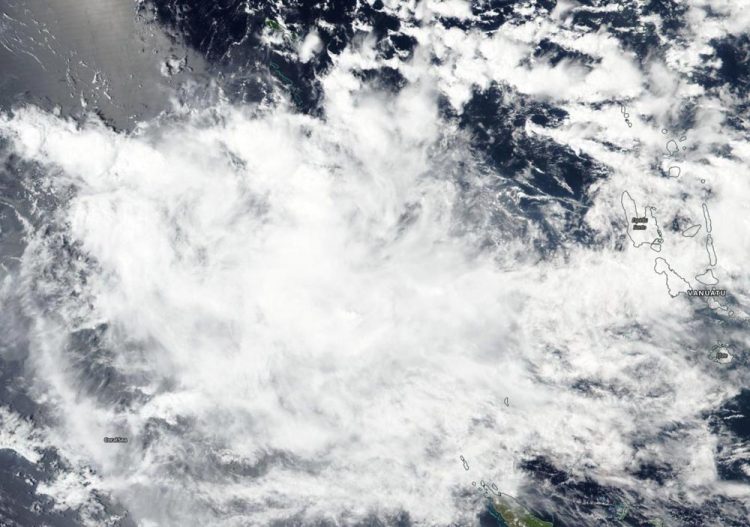NASA-NOAA satellite finds Owen fading in the Coral Sea

On Dec.4, the VIIRS instrument aboard NASA-NOAA's Suomi NPP satellite captured a visible image of Tropical Storm Owen in the Coral Sea, South Pacific Ocean. Owen was southwest of Vanuatu. Credit: NASA Worldview, Earth Observing System Data and Information System (EOSDIS)
In general, wind shear is a measure of how the speed and direction of winds change with altitude. Winds at different levels of the atmosphere pushed against the cylindrical circulation center and skewed it, weakening the rotation.
As a result of the wind shear, Owen weakened from a tropical storm to a tropical depression on Dec. 4.
Early on Dec. 4 the Visible Infrared Imaging Radiometer Suite (VIIRS) instrument aboard NASA-NOAA's Suomi NPP satellite analyzed Owen, and showed a disorganized storm with little thunderstorm development.
The bulk of the clouds and showers were pushed east of the center of circulation from wind shear.
On Dec. 4 at 10 a.m. EDT (1500 UTC) Owen's maximum sustained winds had dropped to 34.5 mph (30 knots/55.5 kph). It was located approximately 519 nautical miles east of Cairns, Australia. Owen was moving westward.
Although it is a depression, the Joint Typhoon Warning Center noted that there is a chance the storm may re-strengthen after two days when the wind shear is expected to relax. Forecasters are keeping an eye on Owen.
Media Contact
More Information:
https://blogs.nasa.gov/hurricanes/tag/owen-2018/All latest news from the category: Earth Sciences
Earth Sciences (also referred to as Geosciences), which deals with basic issues surrounding our planet, plays a vital role in the area of energy and raw materials supply.
Earth Sciences comprises subjects such as geology, geography, geological informatics, paleontology, mineralogy, petrography, crystallography, geophysics, geodesy, glaciology, cartography, photogrammetry, meteorology and seismology, early-warning systems, earthquake research and polar research.
Newest articles

Why getting in touch with our ‘gerbil brain’ could help machines listen better
Macquarie University researchers have debunked a 75-year-old theory about how humans determine where sounds are coming from, and it could unlock the secret to creating a next generation of more…

Attosecond core-level spectroscopy reveals real-time molecular dynamics
Chemical reactions are complex mechanisms. Many different dynamical processes are involved, affecting both the electrons and the nucleus of the present atoms. Very often the strongly coupled electron and nuclear…

Free-forming organelles help plants adapt to climate change
Scientists uncover how plants “see” shades of light, temperature. Plants’ ability to sense light and temperature, and their ability to adapt to climate change, hinges on free-forming structures in their…





















